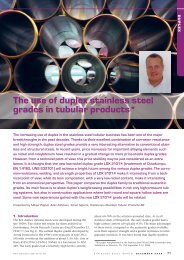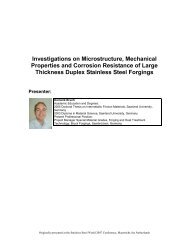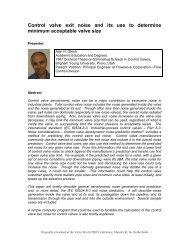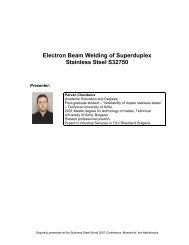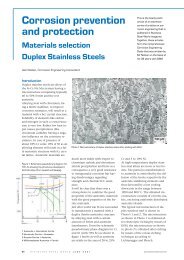Duplex stainless steel welding: best practices*
Duplex stainless steel welding: best practices*
Duplex stainless steel welding: best practices*
Create successful ePaper yourself
Turn your PDF publications into a flip-book with our unique Google optimized e-Paper software.
Table 5 Shielding gas general recommendations.<br />
Welding Process Gas Types<br />
GTAW 99.996%Ar, Ar+2%N2, Ar+5%N2<br />
GMAW Ar+1%O2, Ar+30%He+1%O2, Ar+2%CO2, Ar+15%He+2%CO2<br />
FCAW Ar+1% O2, Ar+20%CO2, Ar+2%CO2<br />
PAW 99.996%Ar<br />
Table 6 DSS and SDSS consumable specifications.<br />
Alloy Process AWS Specification BS EN Specification<br />
DSS GTAW ER 2209 W 22 9 3 N L<br />
GMAW ER 2209 G 22 9 3 N L<br />
SMAW E 2209-15/16/17 E 22 9 3 N L B/R<br />
FCAW E 2209 t0-1/4, E 2209 t1-1/4 T 22 9 3 N L R/P<br />
SAW ER2209+flux S 22 9 3 N L R/P<br />
SDSS GTAW - W 25 9 4 N L<br />
GMAW - G 25 9 4 N L<br />
SMAW - E 25 9 4 N L B/R<br />
FCAW - -<br />
SAW - S 25 9 4 N L + flux<br />
However, N loss is not uncommon<br />
to a depth of 0.5 mm from the surface<br />
of the weld. To correct the<br />
phase balance and improve corrosion<br />
resistance of the weld, it is beneficial<br />
to have additions of 1-2% N<br />
in the Ar shielding and 90% N and<br />
10% hydrogen (H) in the backing<br />
gas. Nitrogen contents above 2% in<br />
the shielding gas can cause degradation<br />
of the tungsten electrode for<br />
GTAW processes. The addition of H<br />
to the shielding gas is not recommended<br />
as it may cause H absorption<br />
in the weld.<br />
Back purging should be maintained<br />
on the joint until at least 6 mm of<br />
weld metal thickness has been deposited.<br />
The oxygen content of the<br />
back purged volume should not exceed<br />
0.25% (2500 ppm) 1 .<br />
Since DSS have relatively high<br />
chromium contents and relatively<br />
low thermal expansion, an oxide<br />
scale appearing as an oxide tint is<br />
produced during <strong>welding</strong> that is<br />
typically thin and difficult to remove.<br />
The appearance and amount<br />
of heat-tint produced during <strong>welding</strong><br />
can be minimized with low levels<br />
of oxygen (below 0.25%) in the<br />
shielding and backing gases, with<br />
minimal moisture in the backing<br />
gas, and with limiting contaminants<br />
on the surface prior to <strong>welding</strong>.<br />
Hydrogen in the Ar backing gas can<br />
adversely affect the appearance of<br />
heat tint, and the base metal’s surface<br />
finish. Shielding gases suitable<br />
for the various gas shielded processes<br />
are listed in Table 5.<br />
Filler Metal Selection<br />
Welding consumables for DSS are<br />
similar in composition to that of the<br />
base material, but the consumables<br />
do require nitrogen and higher levels<br />
of nickel to ensure an appropriate<br />
phase balance in the deposited weld<br />
metal. A nitrogen addition in filler<br />
metals, 0.14-0.20% N, helps to prevent<br />
the formation of σ phases.<br />
Increased addition of Ni promotes a<br />
change in crystal structure from ferrite<br />
to austenite and also delays the<br />
formations of intermetallic phases. A<br />
weld metal microstructure from a<br />
filler composition exactly matching<br />
that of the base metal would yield<br />
high ferrite content, off balancing<br />
the optimal α→γrequired. It is important<br />
that the Cr-content of the<br />
deposited filler metal selected provides<br />
a close match of the base metal.<br />
DSS and SDSS may be welded with a<br />
DSS filler metal that is alloyed with<br />
higher amounts of Ni or, alternatively,<br />
they could be welded with a fully<br />
austenitized Ni-alloy filler metal.<br />
Welding DSS-2205 with ER 2209<br />
filler metal is an effective method of<br />
achieving optimal α→γphase balance.<br />
The ER 2209 filler metal has<br />
equal quantities of Cr-content as<br />
well as 7 to 9% nickel compared to<br />
the 5.5% nickel of the base metal.<br />
Table 6 lists consumable specifications<br />
for DSS and SDSS according<br />
American Welding Society (AWS)<br />
and British Standard (BS).<br />
Welding SDSS-2507 using ER 2209<br />
filler metal is not advised due to under-matching<br />
chemistry. Some fabricators<br />
use AWS ER 2553 for <strong>welding</strong><br />
SDSS-2507; however this practice is<br />
not recommended due to undermatching<br />
Ni-content and unaccept-<br />
www.<strong>stainless</strong>-<strong>steel</strong>-world.net S T A I N L E S S S T E E L W O R L D D E C E M B E R 2 0 0 7 59<br />
<strong>Duplex</strong><br />
ably high addition of copper (Cu).<br />
Increased Cr-content and low<br />
Ni-content of the filler metal will<br />
produce welds and HAZ with excess<br />
ferrite upon <strong>welding</strong>. The increased<br />
Cu additions will produce detrimental<br />
Cu precipitates (ε-phase) as Cu has<br />
a low solubility in ferrite (



